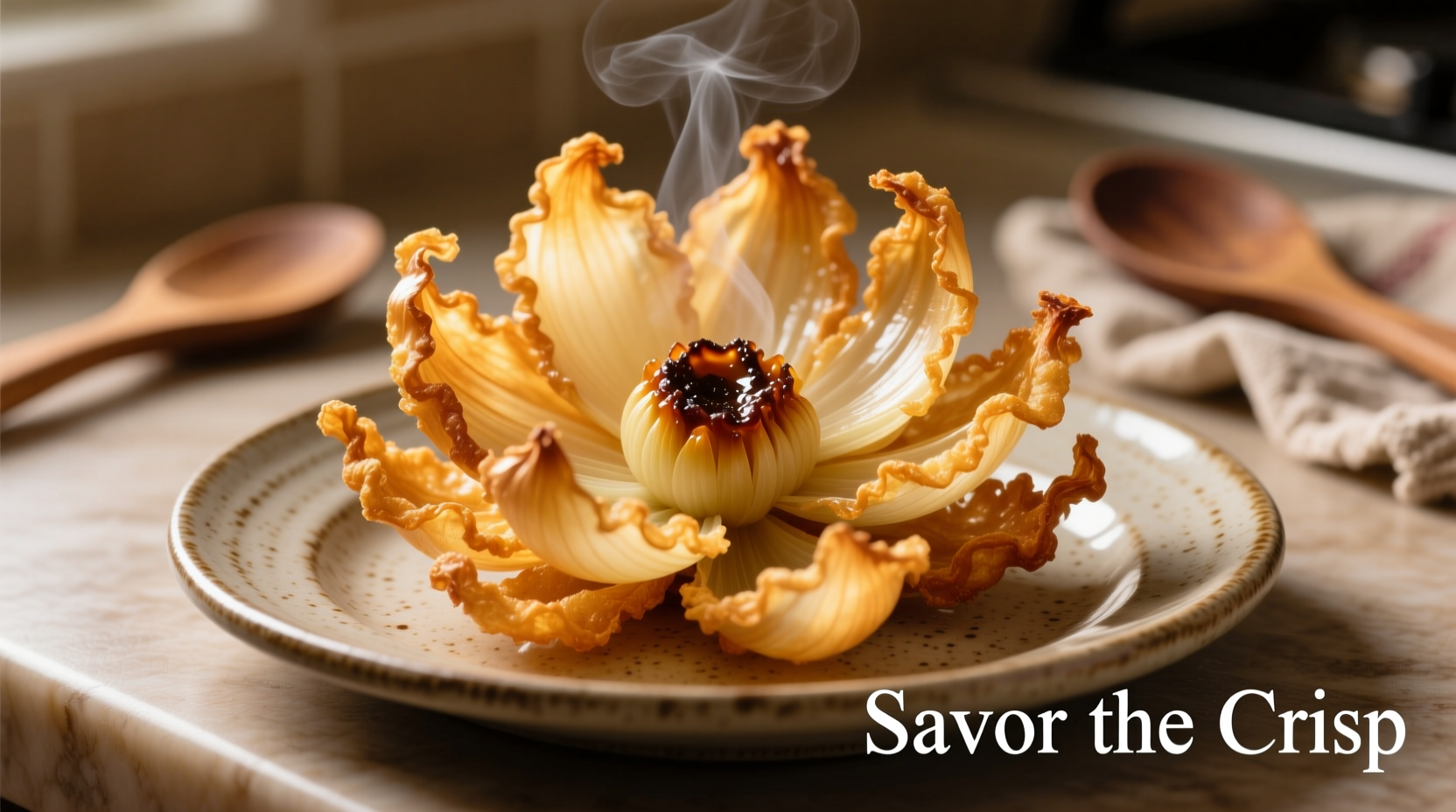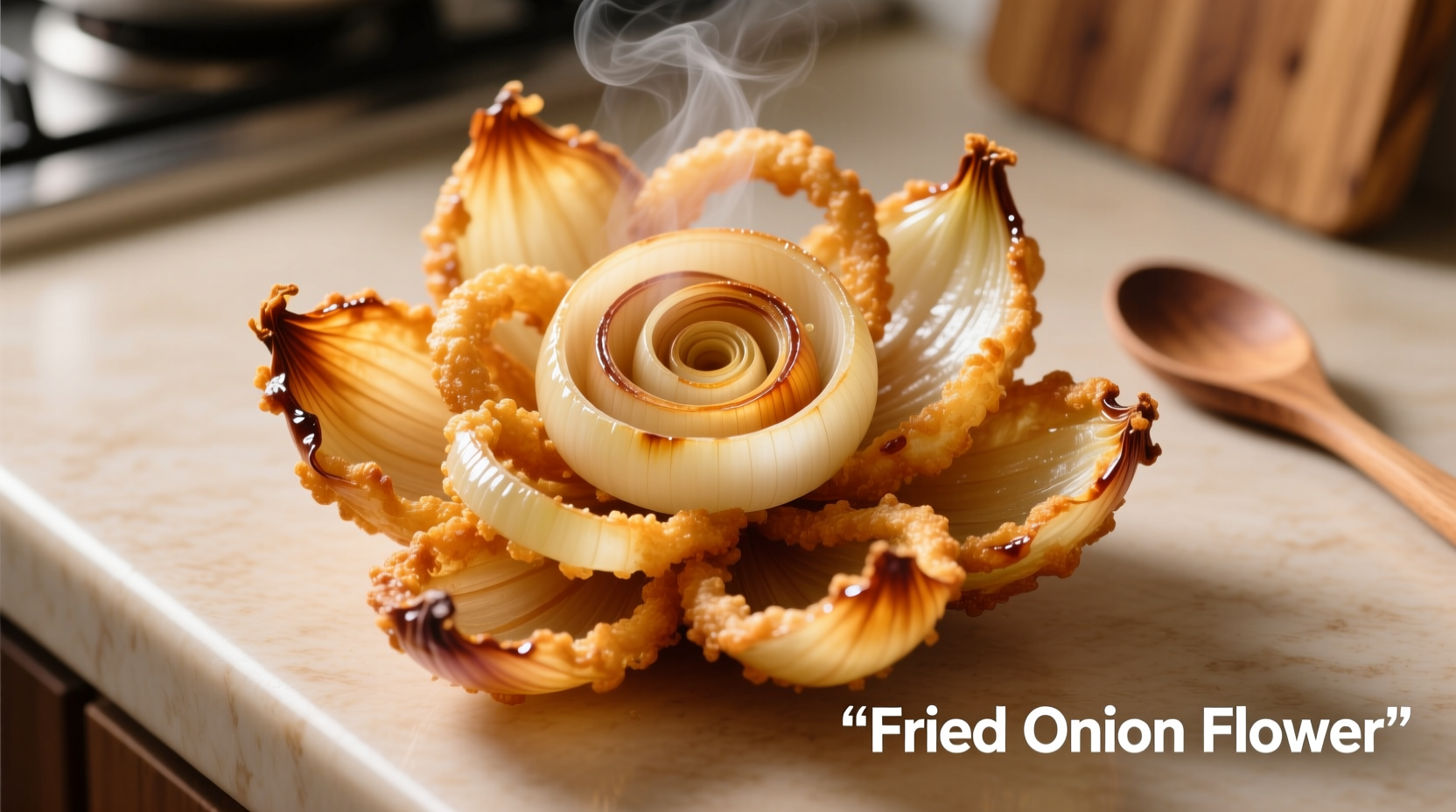Transform ordinary onions into extraordinary centerpieces with this professional technique that elevates a simple vegetable into a show-stopping appetizer. Perfect for game days, dinner parties, or when you want to impress guests with minimal ingredients and maximum visual impact.
What Exactly Is a Fried Onion Flower?
Also commonly called a blooming onion or onion blossom, this culinary creation features a large yellow or sweet onion cut with precise radial incisions, soaked in buttermilk, coated in seasoned batter, and deep-fried. As it cooks, the onion "blooms" open into a flower shape with crispy exterior petals surrounding a tender center. The technique gained widespread popularity through restaurant chains but originated from traditional Southern cooking methods.
| Onion Variety | Best For | Flavor Profile | Recommended Size |
|---|---|---|---|
| Yellow Onions | Traditional preparation | Rich, robust flavor | 3-4 inches diameter |
| Vidalia Onions | Sweeter version | Mild, sweet flavor | 3-4 inches diameter |
| Red Onions | Color contrast | Sharper, more pungent | Not recommended |
| White Onions | Mexican-inspired variations | Crisp, clean flavor | 3-4 inches diameter |
This comparison comes from agricultural research conducted by the USDA Agricultural Research Service, which confirms yellow onions provide the ideal structural integrity and flavor balance for fried onion flowers.
Essential Tools and Ingredients
Creating perfect fried onion flowers requires specific equipment and quality ingredients. Don't attempt this without the proper tools:
- Sharp chef's knife (8-10 inch) for precise cutting
- Deep fry thermometer (critical for temperature control)
- Heavy-bottomed pot or deep fryer (minimum 4-quart capacity)
- Wooden skewers or toothpicks for securing
- Mixing bowls (one for buttermilk, one for batter)
For ingredients, quality matters. Use fresh, firm onions without soft spots. The USDA recommends maintaining oil temperature between 350-375°F (175-190°C) for safe and optimal frying results. Lower temperatures create greasy products, while higher temperatures burn the exterior before the interior cooks properly.
Step-by-Step Preparation Guide
Follow this professional technique to create restaurant-quality fried onion flowers at home:
- Prep the onion: Remove outer skin and 1/4 inch from both ends. Place cut-side down on cutting board.
- Create the flower pattern: Make vertical cuts from top to bottom, spacing about 1/8 inch apart, being careful not to cut through the root end.
- Soak in buttermilk: Submerge prepared onion in buttermilk for 15-30 minutes (this helps the batter adhere).
- Prepare batter: Whisk together 1 cup flour, 1 tsp baking powder, 1 tsp paprika, 1/2 tsp garlic powder, 1/2 tsp cayenne, and salt to taste.
- Heat oil: Fill pot with 2-3 inches of vegetable or peanut oil, heating to 365°F (185°C).
- Batter and fry: Dip onion in batter, letting excess drip off. Carefully lower into hot oil and fry for 3-4 minutes until golden brown.
- Drain and serve: Place on wire rack over paper towels. Sprinkle with finishing salt immediately.

Avoiding Common Mistakes
Even experienced home cooks encounter challenges with fried onion flowers. Here's how to avoid the most frequent issues:
- Onion falls apart: You've cut too deeply through the root end. Leave at least 1/2 inch of root intact to hold the flower together.
- Soggy results: Oil temperature dropped too low. Maintain consistent 365°F and don't overcrowd the fryer.
- Burnt exterior: Oil temperature too high. Use a reliable thermometer and adjust heat as needed.
- Batter slides off: Onion wasn't properly soaked in buttermilk or batter was too thin.
According to culinary research from the Culinary Institute of America, the critical factor in successful fried onion flowers is maintaining precise oil temperature throughout the cooking process. Their studies show temperature fluctuations of just 25°F can dramatically affect texture and oil absorption.
Serving Suggestions and Creative Variations
Elevate your fried onion flower with these professional serving techniques:
- Classic presentation: Serve upright in a tall glass or specialized blooming onion holder
- Dipping sauces: Pair with remoulade, spicy mayo, or citrus aioli for balanced flavor
- Seasoning variations: Add smoked paprika to batter for depth, or finish with everything bagel seasoning
- Dietary adaptations: Use gluten-free flour blend and almond milk for celiac-friendly version
For an impressive presentation, place the fried onion flower in a tall glass or specialized holder that showcases its full bloom. Sprinkle with fresh parsley or chives for color contrast. Many professional chefs recommend serving immediately after frying for optimal crispness—this restaurant-style appetizer doesn't store well due to moisture migration.
Storage and Reheating Guidelines
While fried onion flowers are best enjoyed fresh, you can store leftovers properly:
- Store in airtight container with paper towels to absorb moisture
- Consume within 24 hours for best quality
- Reheat in air fryer at 350°F for 3-4 minutes (not microwave)
- Avoid refrigeration before frying—cold onions cause oil temperature to drop
Remember that deep-fried foods lose crispness over time due to moisture migration from the interior to the exterior. The Maillard reaction that creates the desirable golden-brown color and complex flavors begins to reverse as the product cools, which is why immediate consumption delivers the optimal experience.











 浙公网安备
33010002000092号
浙公网安备
33010002000092号 浙B2-20120091-4
浙B2-20120091-4